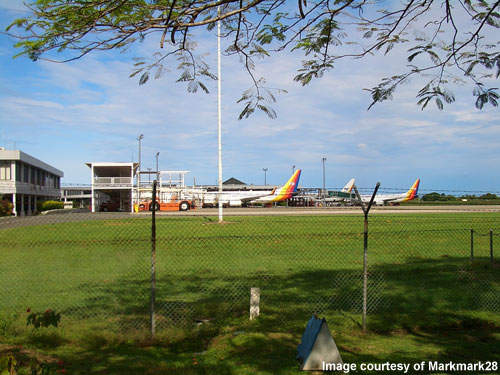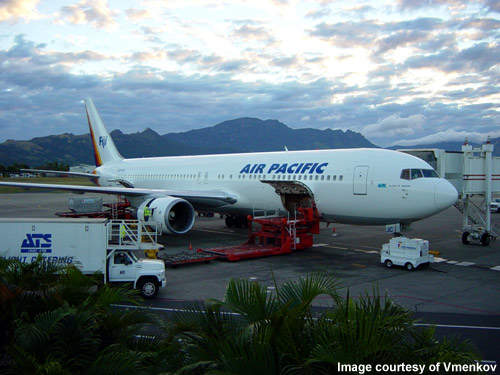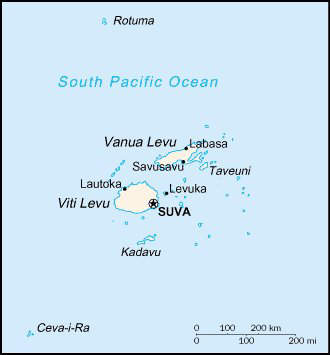Nadi International Airport is part of Airports Fiji Limited (AFL), which controls the operation of 15 public airports in the Fijian islands. Nadi international Airport is Fiji's main international gateway and is one of the two international airports. The airport is located on the west side of the main island of Viti Levu.
Built as an airstrip in 1939 by New Zealand, the project was financed by Fiji's British colonial rulers. During the Pacific War in 1941, the airstrip was utilised under the name USAAF Nadi by the US Army Air Forces.
Following the war, New Zealand took control of Nadi Airport on 20 December 1946. The Civil Aviation Authority of New Zealand began airport operational activities in1947. The Fijian Government took over total control of the airport in 1979, after the nation obtained independence in 1970.
The airport serves a million international passengers every year at its single terminal. In 2003, a major upgrade of Nadi Airport, with an investment of FJ$72m (US$36m) was undertaken by AFL.
Currently, security upgrades, including installation of a surveillance system, an air traffic management (ATM) system and a multilateral system are being planned for the airport. An expansion plan tender for a larger arrival area was issued in the fourth quarter of 2008.
Nadi International master plan
The airport authorities have set out a 20-year master plan for Nadi International Airport, and in 2002, a revised airport master plan was sent to the AFL board. The master plan aims to provide modern facilities and improved services and commercial facilities for passengers.
According to the revised plan, work is scheduled to be completed in two phases. The first phase included meeting growth demands of the airport traffic in 2010, including more commercial space and floor space being developed. Upgrades of traffic and commercial features are planned for the second phase, post-2010.
Singapore Airport Consortium has been awarded the contract to develop the airport facilities in accordance with the master plan. The consortium is a joint partnership between Singapore Changi Airport Enterprise Pte Ltd and PWD Consultants Pte Ltd.
Apron slab replacement
The 26,000m² apron area was replaced in 2006 at a total cost of about FJ$11m (US$6.2m). 300mm-thick slabs were replaced to accommodate aircraft sizes and larger load. The project enhances safety standards, accommodates future growth demands and is compliant with International Civil Aviation Organisation (ICAO) standards.
The project work was executed in several stages to reduce disruptions to the aircraft movements. Downer Engineering handled the construction and Beca (NZ) Erasito Consulting Engineers administered and supervised the contract on behalf of Airports Fiji Ltd.
Runways
Nadi Airport's first runway was built in 1946 after New Zealand took over control of the airport. It was a tarmac runway that cost £46,500. The runway measured 7,000ft by 150ft (2,133m×46m).
Currently there are two runways at the airport – a short cross runway and a main runway. The main runway lies across the beach parallel to Nadi Bay. The length of the first runway is 10,738ft and runway elevation is approximately 63ft. The second runway is 7,007ft long. The first runway contains an instrument landing system (ILS).
Baggage handling
Baggage handling on all international flights at the airport is undertaken by Air Terminal Services (Fiji) Ltd (ATS). Relocation of lost or excess baggage is being aided by WorldTracer's baggage management system.
There is an extension to the existing baggage handling systems and outbound side equipment systems underway.
Security
The airport is equipped with CCTV video surveillance and monitoring. Deployment of automatic dependent surveillance-broadcast (ADS-B) is also planned, and it will integrate next-generation technology and provide oceanic ATM capabilities in the same system.
ADS-B is a surveillance method used to control air traffic and other applications. A first-of-its-kind comprehensive system, the ADS-B solution will not be dependant on radar. A broadcast communications link and global navigation satellite system (GNSS) technology are used in ADS-B. The technology is quite economical and affordable in comparison to the radar.
Installation work will commence in the first quarter of 2010 and is expected to be complete within 18 months.
Era Systems Corporation (Era), a subsidiary of consulting and technology service provider SRA International, Inc. was selected for nationwide implementation of the ADS-B, ATM system and multilateration (MLAT) system in all Fijian airports including Nadi International Airport. Era is a leading provider of flight tracking and surveillance solutions.
Airports Fiji Limited, partnered with 4C Security Solutions Limited (previously BQT Solutions), will upgrade the security and access control services. 4C Security Solutions Limited is a provider of access control systems, surveillance systems, biometric and smart card technology.
The access control system from 4C Security Solutions uses biometric technology. The system also includes miPASS Mifare 13.56MHz smart cards and readers. The biometric fingerprint reader enables user identification in areas of more security.
Air traffic control and management
The air traffic control tower was refurbished in 2008. The air traffic management centre manages the Nadi flight information region (NFIR) located in Namka. Notice to airmen (NOTAM) is relayed through this service via an aeronautical fixed telecommunication network (AFTN). Installation of a new automated message handling system (AMHS), which will replace the current AFTN system, is under way. Work commenced in the first quarter of 2009.
A plan to replace the old ATM system with a new Adacel Aurora air traffic management system is also in place. Era awarded a contract to Adacel in March 2009 to supply the new ATM system. The Era team will provide a replacement system for the Fiji flight information region (FIR).
Cargo
All cargo services at Nadi International Airport are handled by ATS. The cargo facility covers an area of 15,000ft² and has modern integrated material handling feature systems. The facility has a unit load device (ULD) transfer vehicle and a 12t weighbridge.
Security has been made the highest priority, with 24-hour CCTV cameras covering the vicinity of the cargo facility. Special areas are marked for storage of dangerous goods and other special cargo items.
Check-in and ground handling services
Check-in services are being provided by ATS. The company uses a system known as MUSE (multiuser system environment). This improved system allows passengers to check in at any counter. Ground handling services at the airport are provided by ATS. The company monitors load sheets and load control requirements. A movement control service is also provided.
ATS has a 24/7 flight information service facility. Passenger assistance agents also help commuters when they land at the airport.






